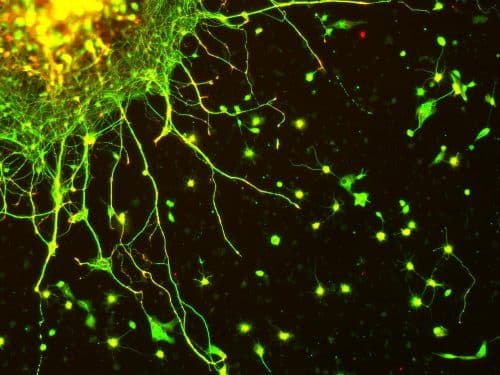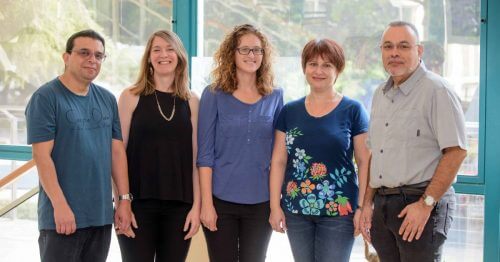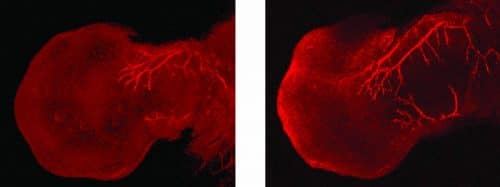Scientists from the Weizmann Institute discovered a kind of "train car" that is essential for sensing the dimensions of cells - a protein called "importin-beta-1". This protein transmits the sensing signal back to the cell nucleus.

A few years ago they found out Prof. Michael Feinzylver and the members of his group in the Department of Biomolecular Sciences of the Weizmann Institute of Science, a sensing mechanism by which nerve cells sense their dimensions. These are tiny "railway tracks" on which the signals "travel"; They are carried on molecular motors, like train cars pulled by a locomotive, from the center of the cell to its edges and back, and the frequency of the signals allows the cell to get an idea of its dimensions. For example, if the "cars" return quickly from the end of the cell to its center, this means that the cell is small. On the other hand, when the signals return after a longer time, and as a result the "cars" "travel" back and forth less often, this shows that the cell is larger.
Now, in a new study which Be famous Recently in the scientific journal Cell reports, the post-doctoral researcher Dr. Rotam Ben-Tov Perry, the faculty scientist Dr. Ida Rischel, and the research student Ella Doron Mendel - together with other members of Prof. Feinzilber's group and with researchers from other institutions in Israel and abroad - revealed how a mechanism works Sensing this at the molecular level. First, the scientists identified the essential "car" for sensing the dimensions - a protein called "importin-beta-1": a messenger RNA molecule, which encodes genetic instructions for the creation of the importin-beta-1 protein, travels on the molecular "train tracks" from the center of the cell to its edge; When this molecule reaches the end of the "stripes", the construction of importin-beta-1 begins, and this protein transmits the sensing signal back to the cell nucleus.

To find out how the messenger RNA of importin-beta-1 "travels" on the molecular "tracks", the scientists used original research material: from a slaughterhouse in the north of the country, they collected the femurs of cows, which are usually thrown in the trash because it is forbidden to eat them according to kashrut laws. The biblical femoral tendon is actually not a tendon but a nerve, which contains the longest nerve processes in the body. Within these extensions the scientists identified a protein called "nucleolin". This protein binds to the messenger RNA of importin-beta-1, and together they set off - like a train with two cars, from the cell's nucleus to its end.
When the scientists disrupted the activity of the protein nucleolin using an experimental anti-cancer drug that binds to this protein, the two "cars" - both the nucleolin and the importin-beta-1 messenger RNA - remained in the center of the cell, or "traveled" only a short distance. Since the distance was so short, the frequency of movement on the molecular "railway tracks" was very high, and this misled the nerve cell, causing it to feel that its extension was much shorter than it actually was. In response to this, the nerve cell began to grow at a rapid rate - sometimes five times faster than normal - and grow a very long extension. The experimental drug that binds to nucleolin allowed scientists to trick not only nerve cells, but other body tissue cells as well, causing these cells to grow to abnormal sizes.

These findings may have implications for the study of cancer, and the study of the regrowth ("regeneration") of nerve tissue. The protein nucleolin is expressed in large quantities in cancer cells, and the experimental drug used by the scientists in the study, which binds to nucleolin, kills the tumor cells, but its exact mechanism is unknown. The new study, which indicates that nucleolin is involved in the sensing mechanism that controls cell growth, may open a new direction in the development of anticancer drugs. Furthermore, an in-depth understanding of the cell size sensing mechanism, which controls the growth rate of nerve cells, may in the future help in the development of means to accelerate the regeneration of nerve fibers after injury.
Also participating in the study were Dr. Marco Tranzio, Stephanie Alber, Dr. Sandeep Cooley, Albina Lin, Dr. Meir Rosenbaum, Dr. Dimitri Yudin, and Prof. Avraham Yaron from the Department of Biomolecular Sciences of the Institute; Dr. Vera Shinder from the Department of Chemical Research Infrastructures of the Institute; Dr. Vasim Jaraisi from "Tnuva"; as well as scientists from the laboratories of Prof. Jeff Twiss from the University of South Carolina, Prof. Al Burlingame from the University of California, and Prof. Clifford Wolff from Harvard Medical School.
Science books
Molecular motors move inside cells in "steps" of about 8 nanometers each, at an average speed of 125 "steps" - or 1 micrometer - per second. If a person walked at the same pace, his speed would reach 450 km/h.

2 תגובות
Maybe this is IPP 204106?
articles:
http://adisinsight.springer.com/drugs/800027743
https://clinicaltrials.gov/ct2/show/NCT01711398
Is the experimental anti-cancer drug mentioned in the article already given to humans? May I have details?